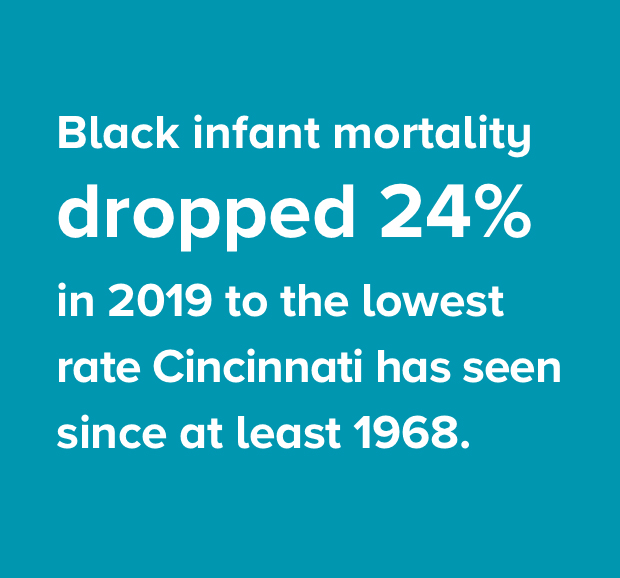Drop in Black Infant Mortality is Encouraging — But “We Have a Long Way to Go”


Black infant mortality dropped 24% in 2019 to the lowest rate Cincinnati has seen since at least 1968. That was cause for celebration at Cradle Cincinnati, an organization founded by the Cincinnati Children’s Perinatal Institute in 2012 as a collaborative effort among parents, caregivers, healthcare professionals, government agencies and community members with a shared commitment to reduce infant mortality in our community.
Perinatal Institute Co-Director Jim Greenberg, MD, and Ryan Adcock, executive director of Cradle Cincinnati, highlight this progress and the work that remains.
Where did the idea of Cradle Cincinnati come from?
JG: More than 10 years ago, Perinatal Institute leaders noted that, despite our great clinical and academic performance, our regional infant mortality was among the worst in the United States. We made a commitment to be part of the solution. After several years of planning we launched Cradle in 2012 in partnership with Dr. Elizabeth Kelly, an obstetrician and executive vice chair of the Department of Obstetrics and Gynecology at the University of Cincinnati College of Medicine. The organization is based at Cincinnati Children’s and supported by more than 15 major partners.
Cradle Cincinnati measures its success by the infant mortality rate in babies born to moms who reside in Hamilton County at the time of birth (Cincinnati Children’s is located in Hamilton County). As we collected and analyzed the data, we recognized the glaring disparity between race and infant mortality. For Black families, that racial disparity can’t be explained by biology or even social class. We appreciated that we must reduce Black infant mortality to impact the overall Hamilton County rate. As Cradle Cincinnati has evolved, we have become more and more focused on Black infant mortality rates and all the factors that contribute to it.
How has Cradle Cincinnati moved the needle in Hamilton County?
RA: We work with community partners to provide wrap-around baby, health and social services. But our success is also about a heavy emphasis on inclusion. Black community members drive strategy, decision-making and programming at every level of our organization. We like to say that our programs are by Black women for Black women. A good example of that is Queens Village, a supportive community where Black women can come together to relax, repower and take care of themselves and each other. Last year about 1,000 women participated in Queens Village activities, including wellness workshops, yoga classes and poetry nights.
How are providers within the Perinatal Institute addressing concerns about race and equality in the clinical setting?
JG: We are actively working to ensure that the care Black mothers and babies receive is equitable and free of the potential for disparities. For example, we are making diversity and inclusion training available to our prenatal care partners. We facilitate the inclusion of community health workers and other providers in the delivery of prenatal care.
Are you optimistic?
RA: It’s incredibly encouraging that infant mortality is going down in certain neighborhoods, and that people of all backgrounds are raising a hand to get involved — from primary care providers and public health officials to Black mothers and grandmothers.
But it’s a long, long journey. From 2014 through 2018, Hamilton County averaged 59 Black infant deaths per year. In 2019, the number dropped to 45. That shows good progress, but to have equity with the local white infant mortality rate, we’d need to see a reduction to 20 black infant deaths in a year. We have a tremendously long way to go.
Learn more in the 2019 Cradle Cincinnati annual report.

